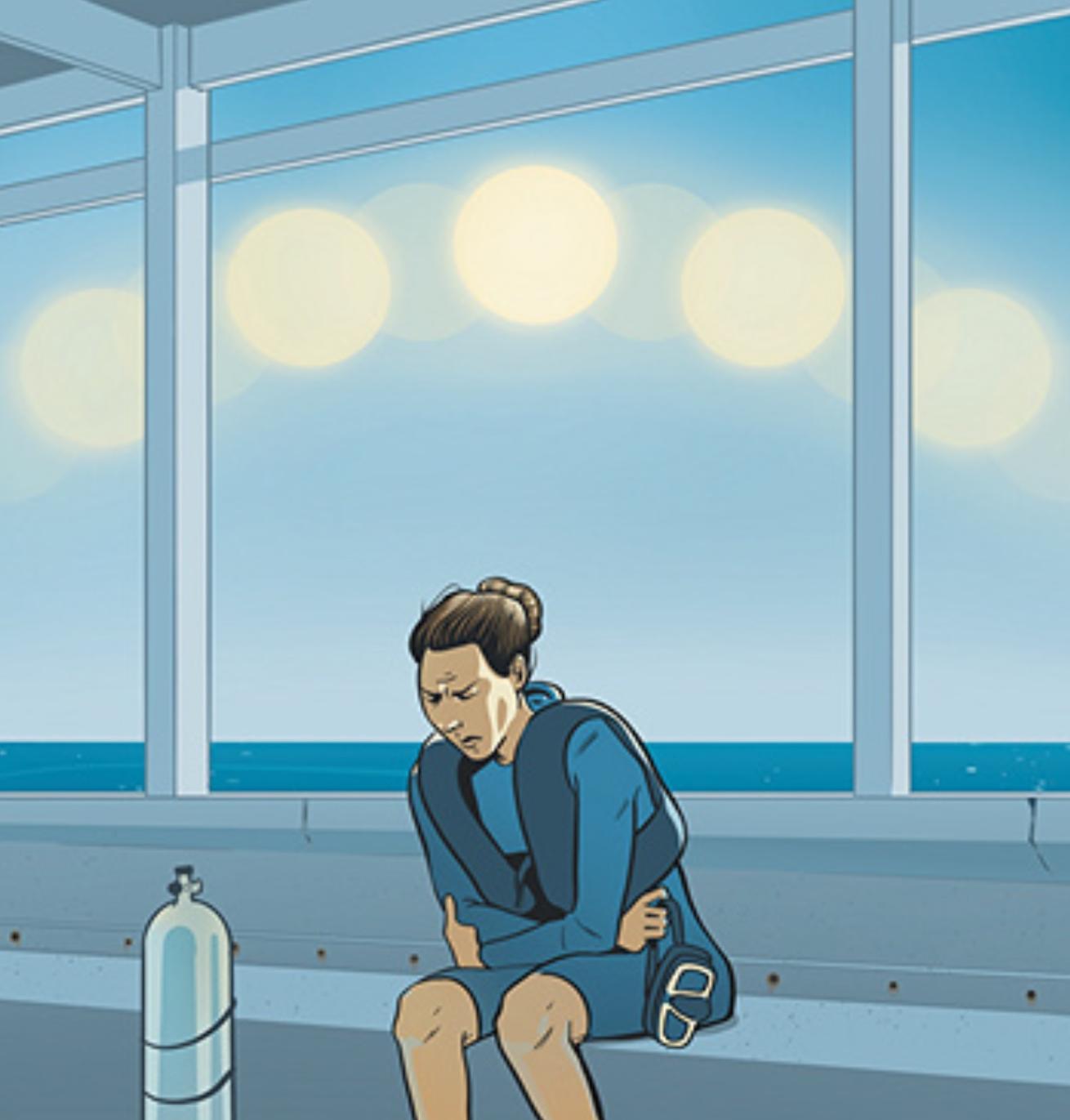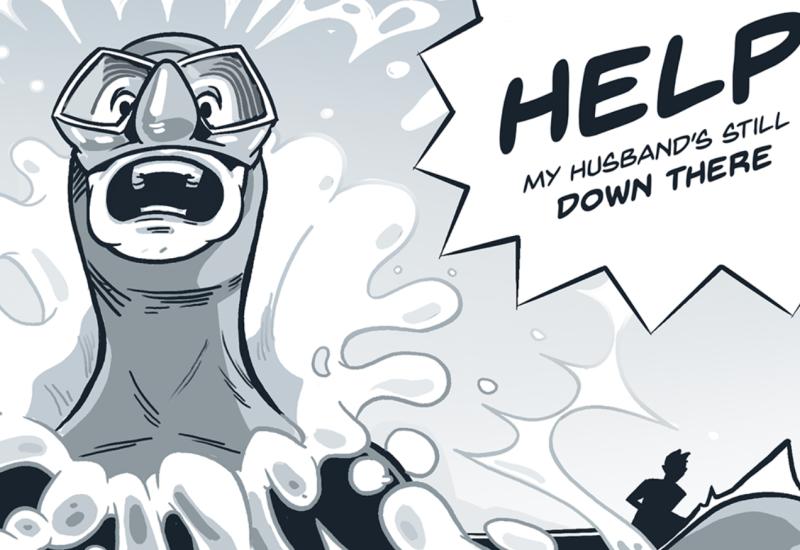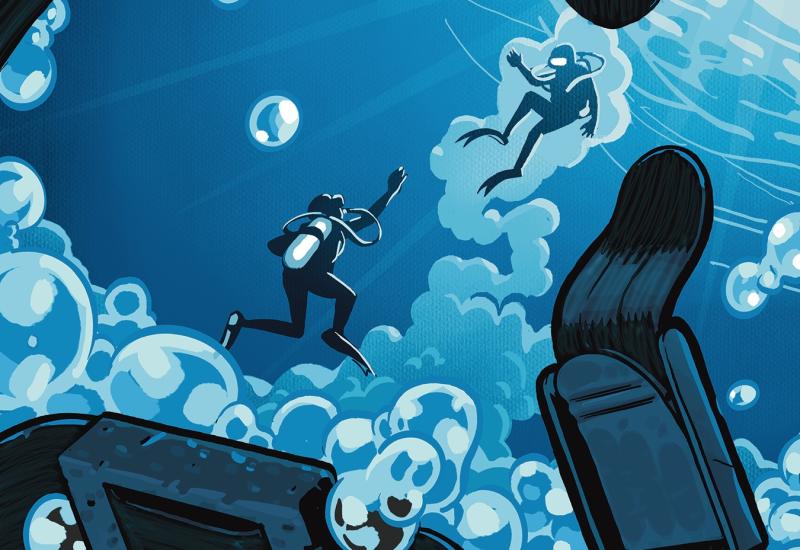Delayed Consequences | Lessons for Life

Steven P HughesA diver begins to feel the first symptoms of DCS after surfacing.
Maggie spent the entire time on the shipwreck hovering along the deck before making her ascent. Back on the boat, she realized there was a problem.
The Diver
Maggie, a 40-year-old woman with no known health problems, was certified seven years earlier and had an advanced open-water certification.
The Dive
Maggie stayed just above the deck of the wreck at 100 feet the entire 17-minute dive. She breathed nitrox 32, a mix with 32 percent oxygen. She stayed within no-decompression limits and completed a safety stop before surfacing.
The Accident
The problem began immediately after Maggie got on the boat. She felt lower-abdominal pain and decided not to dive anymore. She breathed 100 percent oxygen for two hours until it ran out as the other divers on her boat made their second dive. She didn’t want to seek medical attention beyond that.
About three hours after she surfaced and symptoms began, the boat arrived back at the dock and Maggie went home. The oxygen first aid had reduced the symptoms temporarily, but when they returned later that evening, Maggie went to the local emergency department.
The treating physician determined that the skin from the waist down was numb and prickly. Maggie also experienced difficulty walking due to weakness in her left leg. She said it felt like her muscles did not want to work properly and she was having trouble standing. She was also unable to urinate.
Maggie was immediately transferred to the nearest hyperbaric chamber and was prescribed a U.S. Navy Treatment Table 6. She didn’t experience much relief from her symptoms after the standard chamber treatment of four hours and 45 minutes, but after two additional treatments she began to feel relief. Following the first treatment, Maggie still could not urinate and required a catheter. The doctor prescribed several additional shorter hyperbaric chamber treatments. Eventually her symptoms resolved enough that she could go home for physical therapy.
Analysis
Divers do everything they can to mitigate the risk of decompression illness (DCI), but it is impossible to completely eliminate that risk, even when diving well within no-decompression limits. Despite breathing enriched air nitrox, Maggie dived within the bottom-time limits of air. Theoretically, that should have given her an even greater margin of error with regard to nitrogen absorption, but she still got DCI. Maggie also made a slow ascent with a safety stop.
The severity and presentation of her symptoms suggests Maggie developed a form of DCI that affected her spinal cord. When a bubble forms on the spinal cord it can cause numbness and tingling of the lower body, muscle weakness and an unsteady gait.
The most important lesson to learn from this incident is to suspect DCI, which includes both arterial gas embolism and decompression sickness, any time you feel unusual symptoms within a few hours of surfacing from a dive. Delayed treatment is one of the biggest problems when addressing cases of DCI.
Sometimes you can be your own worst enemy. No one wants to think they might have gotten “bent” by making a mistake. But sometimes DCI can occur even when a diver follows all the rules. Rather than admit to feeling off, divers will often deny symptoms, make excuses or self-medicate with pain relievers or alcohol. It’s often only after their symptoms persist the next day that they seek treatment. That delay can make it harder for a full resolution of the problem.
In Maggie’s case, she did the right thing by not diving again and breathing oxygen first aid on the surface. She could have had a better outcome had she sought immediate emergency medical help right away by canceling the second dive for the day. Waiting for the second dive to be over while her oxygen ran out and then driving home before seeking medical help delayed Maggie’s care by several hours.
Signs and Symptoms of DCI
Unusual fatigue
Skin itching
Pain in joints or arm, leg or torso muscles
Dizziness or vertigo
Ringing in the ears
Numbness, tingling and/or paralysis
Shortness of breath
A blotchy rash
Muscle weakness or paralysis
Difficulty urinating
Confusion, personality changes or bizarre behavior
Amnesia
Tremors
Staggering
Coughing up bloody, frothy sputum
Unconsciousness or collapse
Lessons For Life
- Know the signs of DCI. Take a class in oxygen first aid and learn the signs of DCI so you can respond to a diving emergency—your buddy’s or your own.
- Have an emergency plan. Know what to do, and whom to call, when there is a problem at a dive site. Find out where the closest decompression chamber is to each dive site, and carry active dive insurance.
- Speak up. Don’t be afraid to tell others if you are feeling unusual symptoms after a dive. Know that injured divers will sometimes deny the possibility of DCI, and advocate for them if you recognize a potential DCI incident.










